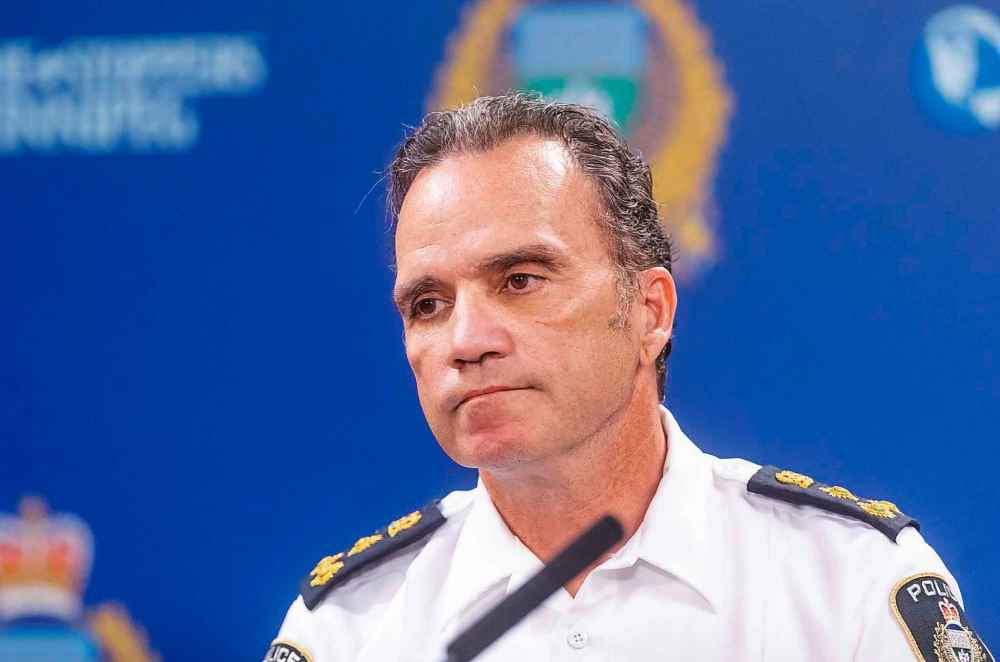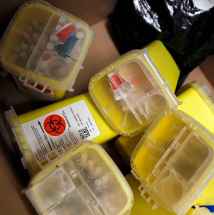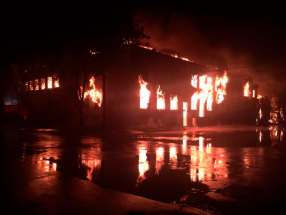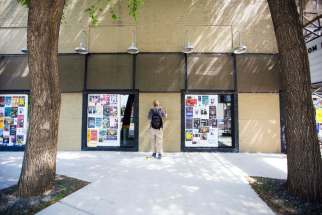Police chief rings alarm bell, province slow to answer
Read this article for free:
or
Already have an account? Log in here »
To continue reading, please subscribe:
Monthly Digital Subscription
$1 per week for 24 weeks*
- Enjoy unlimited reading on winnipegfreepress.com
- Read the E-Edition, our digital replica newspaper
- Access News Break, our award-winning app
- Play interactive puzzles
*Billed as $4 plus GST every four weeks. Offer only available to new and qualified returning subscribers. Cancel any time.
Read unlimited articles for free today:
or
Already have an account? Log in here »
Hey there, time traveller!
This article was published 22/07/2019 (2020 days ago), so information in it may no longer be current.
The only thing worse than Winnipeg’s soaring crime numbers in 2018 is the gloomy reality this year is looking even worse.
That was the message a visibly distraught Danny Smyth delivered Monday, when the Winnipeg Police Service chief practically pleaded with the provincial government to take swift action against a methamphetamine crisis fuelling a crime spree and putting police officers at risk.
Smyth’s assessment of the situation was stark.

More cops are getting needle-stick injuries. Seven have been pulled off regular duty to assess their physical and behavioural health. The 911 call centre is swamped, and they’re losing “good people” who can’t cope with the stress.
The Bear Clan Patrol community outreach group, which monitors city streets most nights, collected 4,000 discarded needles in 2017, Smyth said.
They picked up 40,000 in 2018; halfway through 2019, they’ve already collected a staggering 60,000.
It’s a crisis, and it’s not confined to a small group of illicit drug users. It’s driving up violent and property crimes throughout Winnipeg, which means the entire city is at risk.
Robberies were up 10 per cent city-wide in 2018, but they jumped 14 per cent in the east and southeast part of Winnipeg (44 per cent above the five-year average). Property crimes increased 19 per cent, but were up 26 per cent in the west and southwest.
Winnipeg Police 2018 annual statistical report
Statistics Canada also released national crime statistics Monday. The results were grim: Winnipeg’s violent crime severity index increased four per cent last year, and remained the highest in the country.
The total crime severity index, which includes property crimes, jumped 10 per cent in Winnipeg in 2018, and was the third-highest in Canada.
Increases in break and enters, robbery, shoplifting, and fraud all contributed to the higher crime rates.
Overall crime in Winnipeg is still lower than it was 10 years ago, as it is for the rest of Canada. But it is on the rise again, growing since 2014.
However, what Smyth will tell you is the type of crime cops are seeing today is different than a decade ago.
It’s more erratic and unpredictable. It’s not just alcohol-related or driven by other forms of drugs. It’s specific to meth consumption, and it’s dangerous to anyone around it, including first responders.Along with the introduction of crack cocaine 25 years ago and the growth of criminal gangs that followed, the proliferation of meth is the biggest “game changer” Smyth says he’s seen in his policing career.
Along with the introduction of crack cocaine 25 years ago and the growth of criminal gangs that followed, the proliferation of meth is the biggest “game changer” Smyth says he’s seen in his policing career.
And it’s getting worse. Smyth says the numbers continue to soar this year.
Winnipeg is on track to record one of its highest homicide rates, with 25 such cases thus far in 2019.
The police chief continued to sound the alarm bell Monday. He says the province could do more now — including opening detoxification centres and safe shelters for drug users — to alleviate pressure on police resources and increase public safety.
(It is worth noting Smyth poured cold water on the idea safe injection sites might help curb Winnipeg’s issues, saying he doesn’t think the controversial programs, which mostly help prevent opioid overdoses, would help combat meth use.)
None of this appeared to trigger a greater sense of urgency from the Pallister government.

Justice Minister Cliff Cullen repeated Monday the list of steps Manitoba has taken recently to help combat illicit drug use, including more treatment beds and the establishment of a drug court. In a conference call with reporters, he said the province has already acted on half the recommendations of a recent tri-level task force report on illicit drug use. He said the province plans to do more.
If anyone was looking for a more urgent tone from the justice minister in response to Smyth’s call to action over the past week, Cullen didn’t give it.
The Pallister government just doesn’t seem to share the same level of urgency on this file.
tom.brodbeck@freepress.mb.ca


Tom Brodbeck
Columnist
Tom has been covering Manitoba politics since the early 1990s and joined the Winnipeg Free Press news team in 2019.
Our newsroom depends on a growing audience of readers to power our journalism. If you are not a paid reader, please consider becoming a subscriber.
Our newsroom depends on its audience of readers to power our journalism. Thank you for your support.













